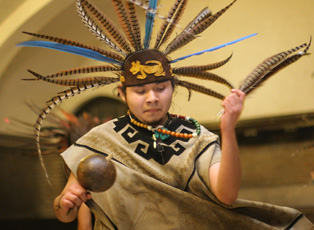Activist groups celebrate ancient traditions

Victor Arroyo, member of the Chicago-based Aztec dance group, Nuahalli, performs a traditional dance at the McKinley Foundation, 809 S. Fifth St., on Saturday night. The performance was presented by Movimiento Estudiantil Chicano de Aztlan. “The feather Josh Birnbaum
October 31, 2005
To the beat of drums and the soothing smell of zap incense, Alma Montes, 26-year-old Mexica performer from the Nuahalli dance group shouted, “We are not mascots” while dancing the “Danza del Santeo” (Dance of the Maize). The Movimiento Estudiantil Chicano de Aztlan, a registered student organization, hosted “Poes¡a Peligrosa” (Perilous Poetry) at the McKinley Foundation, 809 S. Fifth St. on Saturday.
The Movimiento organized the event to highlight the issues that are perceived as politically controversial, such as the University’s Chief Illiniwek. This movement, which was the organization’s first event, tried to address issues that people tend to “put under the carpet”, said Cindy SanMiguel, sophomore in LAS and vice-president of the Movimiento Estudiantil Chicano de Aztlan.
SanMiguel explained that the group “really wants to express that this is not a show for entertainment.”
“It is about honoring the culture,” SanMiguel said. “And above all that, we are a political organization.”
The event opened with a two-hour ceremony that featured the Nuahalli Mexica dancers. During the ceremony, the group of seven women and two men performed several “danzas,” a type of ritual dance, including La Danza del Fuego (Dance of the Fire), del Venado (deer), Coatlique (serpent woman), and Xipetotec (rebirth).
Get The Daily Illini in your inbox!
Before each performance, the dancers explained to the audience the nature of their attire. The copiles (headbands) signify the elements of energy and the feathers on the headband represent the rays of light from the sun. Since the water element is considered to be a feminine element, the shells on their feet represent a women’s energy. Throughout the ceremony, the group called upon the four elements: water, wind, fire and earth.
“This is what we stand for, honoring the Native Americans,” SanMiguel said. “What happens in the football games is not honoring the natives.”
The group of dancers helped the audience understand some of the ancient traditions of the Mexicas, who are more commonly known as the Aztecs. Mexica is their original name, and Aztecs is the name given by the Spaniards. The organization wanted to show the University that there is more to the Native American cultures than just an image of Chief Illiniwek.
This organization was inspired by a Chicano movement in the late 1960s, and it has chapters all over the country.
“This group focuses on issues on campus such as the Chief issue, low minority enrollment and the connection to the community,” SanMiguel said.
The group of dancers invited the audience to join the sacred circle and dance along with them. After a brief prayer, the audience began to dance in the circle. In the center of the circle, there were two drums and an “altar de los muertos” (altar for the day of the dead). The audience danced around the altar and then throughout the entire room.
Students, faculty and people in the community attended and participated in the event as well.
Miguel Enriquez, a Champaign resident of three years, said that this was the first time he attended an event such like this one.
“This type of events makes me think about my beautiful Aztec culture,” Enriquez said after dancing along with the group for almost 20 minutes.
After the Mexica ceremony, there was an open mic session. Several students read political poetry. One of the Mexica dancers shared two of her poems. The first one was entitled “Digging ourselves from our own martirio” (suffering), and the second poem was called “vivora” (serpent).
Aide Acosta, graduate student in anthropology, said that it was important to have a place where people can “express politicized form of expression against the mainstream ideas.”
During the closing of the Mexica ceremony, the dancers gave thanks to their ancestors. Facing east, west, north and south, the group prayed and asked for energy from the creator, women warriors, children and the dead.
“All those people that have died so that we can keep our traditions- we honor them,” Montes said.






